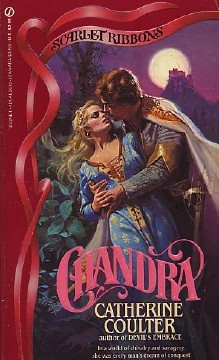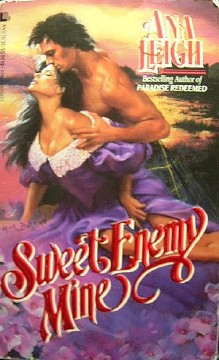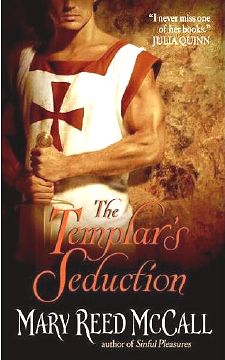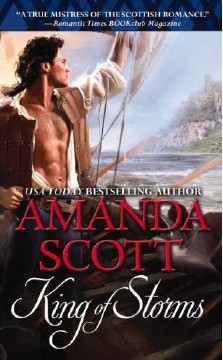

The Historical Romance Genre: Mediæval to Modern
This began as a specific review of one novel, which Eruanna had sent to me. But I now want to broaden this out to discuss the modern (largely American) historical romance genre, and why it is problematic for anyone who cares about history.
The modern US 'historical romance' genre took shape with the early 1970s “bodice-rippers” of Kathleen Woodiwiss and Rosemary Rogers, belated descendants of Kathleen Winsor’s Forever Amber (1944). These novels are consumed – there is no other word for it – addictively by millions of women. The central ‘romance’ - laced with often highly explicit sex-scenes - takes place in a historical setting incorporating subplots or back-stories of political intrigue and conflict. “Many readers say they not only enjoy the romance and excitement of historicals, but they feel they are learning something about the history of a different place and era”, writes Phyllis Taylor Pianka (How to Write Romances, p. 104) . Janice Radway’s research supports this: readers believe it lends educational value to a habit which they fear would otherwise be dismissed as escapist self-indulgence. (Reading the Romance: Women, Patriarchy and Popular Literature, 1991 edition, pp. 106-113)
However, there is a conflict between the claims of accuracy made for the books (by authors and readership alike) and their actual historical content. Kathryn Falk writes that “readers have a good handle on [historical] details and will be extremely disappointed if you don’t get everything correct”, but her notion of reliable sources is rather odd (the self-styled 'Prince Michael of Albany' as an authoritative Scottish historian?!) (How to Write a Romance for the New Markets, vol. 1, pp. 147-48). Julie Beard recommends children’s textbooks as research aids because they are “written in a simplistic but very informative way that’s perfect for writers” (The Complete Idiot’s Guide to Getting Your Romance Published, p. 172); but that “simplistic” approach too often equates with oversimplification and a preference for popular myths which have been discredited by modern scholars. Where authors have read reputable works, it's clear that the 'rules' of the genre take precedence over them.
However much research is carried out, historical romance protagonists remain contemporary soap-opera characters in fancy dress. This is most apparent in the heroine, invariably “a woman out of step with the repressive society into which she is born”, according to Penelope Williamson (“By Honor Bound: The Heroine as Hero”, in Krentz, ed., Dangerous Men and Adventurous Women, p. 128). As a result, she is seldom credible in context because of her anachronistic attitudes and behaviour. Anne Scott MacLeod has outlined the problems inherent in this modernisation of characters in her online article, Writing Backward: Modern Models in Historical Fiction. Her examples are largely taken from novels for younger readers, but her points hold true for most popular historical fiction and films. It is not a new problem: the father of the modern historical novel, Walter Scott, began it (his viewpoint-heroes are essentially Regency-era Edinburgh Episcopalian bourgeois in fancy-dress), but it has become more overt in recent times, especially with the depiction of female characters. The St Jude's Abbey novels by Jocelyn Kelley, which focus on the alumnæ of a convent/women's martial arts school founded by Eleanor of Aquitaine (!) belong firmly in the realm of fantasy. Tina St John's Black Lion's Bride takes a similar line with a Muslim heroine, Zahira, daughter of the 'Old Man of the Mountain', who is sent by her father to kill King Richard at Ascalon. (NB: Nizari Assassinations were suicide missions, and women never carried them out.) It would be refreshing to read about characters who embodied their time and culture… As it is, romance heroines as a species tend to be the published equivalent of what in fanfiction are termed 'Mary-Sues'.
Themes and subjects often take their lead from cinema and non-genre popular writing trends. The historically execrable Braveheart has fuelled the vogue for Scottish-set mediæval romances, but they have as little to do with real Scotland as the film. The Da Vinci Code & al. has led to a fashion for novels with Templar or ex-Templar heroes. Again, these feed more on modern myth-making and pseudo-history than on reality. Mary Reed McCall's Templar's Seduction is essentially a variant of Le Retour de Martin Guerre, but with a happy ending. The genre demands happy endings, which is, I think, one of its weaknesses: if the outcome of a fictional story is a foregone conclusion before you even begin to read it, simply because of its genre, where is the suspense? Any dramatic tension generated by the characters facing risks is lost when you know in advance that they are never in any real danger. The genre is about reassuring readers; but there was little reassuring, and much precarious, about mediæval life. To remove the possibility of a tragic outcome (because the novel would then no longer be classified as a romance) is, I think, a weakness: many of the great, most memorable, most beloved love stories in literature are tragedies. To deny that seems to me a sign of immaturity in the culture of the genre.
 |
 |
Lady Chandra… |
meet Breyandra! |
Character names seem to be a major problem for writers of historical romances. They are torn between exoticism (identifying an 'extraordinary' character with an 'extraordinary' name) and the familiar (something that the readers will not find alienating or too difficult to pronounce). Modern cultural diversity, especially in the US, seems to make writers forget than in mediæval Europe, some names and styles of naming were specific to particular cultures; also that some were tied to particular geographical areas, even within a fairly small country. 'Damien' and 'Damian' are popular in historical romances because of the devilish overtones of The Omen films, but these have always been more popular in Mediterranean countries, where the cult of St Damian was stronger, than in northern Europe, where other saints were more popular. Some romance names are sheer fantasy. A heroine called 'Raven' (and there are several!) sounds like a Goth, in the modern sub-cultural sense, although you would get away with a mediæval Spanish 'Magpie' (Urraca, a name in the Castillian royal house, although it's better not to translate). 'Chandra', for a 13C European (Catherine Coulter, Chandra, aka Warrior's Song), is absurd. I am baffled completely by Ana Leigh's use of the name 'Breyandra' for the heroine of Sweet Enemy Mine, a tale of feuding Frasers and Gordons: what language is it meant to be? I could accept it as the name of a science-fiction or fantasy character on another planet, but for a Renaissance-Early Modern Scotswoman, surnamed Fraser? Modern-style use of surnames as first names and 'cute' abbreviations may make some readers feel more at home, but are equally jarring. Amanda Scott's ' 'Sir Giffard Maclennan' in King of Storms is unlikely in 14C: abbreviated to 'Giff', he sounds like a computer graphic format! I still cannot get over Aleen Malcolm's 18C heroine Cameron(a) (The Taming trilogy, which is disturbing on so many levels), saddled with a name that means 'Crooked Nose' in what's meant to be her first language. No wonder she's a psychologically unstable little shrew, who punishes her own children with such names as… Raven, Kestrel, Rue, Rowan and Lynx! Malcolm also has an 18C aristocratic Highlander called Darach ('Oak-tree') in Children of the Mists: again, this is unlikely. And I cannot take seriously any novelist who ascribes the name 'Fiona' to any pre-late 19C character. It was invented in the 1880s/90s as a pen-name by 'Fiona MacLeod'… whose real name was William Sharp. Surnames and middle names are often used in a modern way, not patronymics or territorial designations. This is not confined to the romance genre, but cuts across popular historical fiction: one of the worst examples is in Noah Gordon's The Physician, in which the 11C Anglo-Saxon hero is called 'Rob J. Cole'. This put me off at the first line (as his mother calls his name), as bad naming always does.
But all of these faux-pas with names which break suspension of disbelief as soon as I see them in the cover-blurb, are easily avoidable: it just takes a little bit of research and not having a tin ear.
Geography is also a problem in a genre dominated by US writers, for whom Europe, especially Scotland, seems to be regarded as a historical fantasy theme-park. For example, Reed McCall has a place called 'Strathness' in Kinross, which makes no sense, unless she has truncated 'Strathkinness' (in Fife, but the Kinnessburn rises in Kinross), without thought of the meaning. 'Strath'='river valley'. 'Ness'='promontory/headland'. The Kinnessburn ends at St Andrews, so that's fine. But Kinross is land-locked as a county, so a place called 'Strathness' doesn't fit unless the Fife end of things is explained. It also sounds too much as if it belongs on the River Ness in Inverness-shire. Her 'Dunleavy Castle' sounds more Irish (not even Highland) than Lowland, and we are given little indication where in the Lowlands it is meant to be. In an 18C setting, Aleen Malcolm places some scenes in Glenrothes. Had she written Leslie or Markinch, fine: but Glenrothes is a post-WW2 'new town': an 'old inn' there conjures visions of distressed concrete. She has characters riding along Princes Street before it was built: they would be deep in mud, before the draining of the Nor' Loch! She also has a Highland-type estate called 'Glen Aucht' which appears to be in the vicinity of Leven in Fife, and white slavers operating from Crail. For anyone who has lived in Fife, the only response is <mindboggle>. It is always curious to see your own home depicted as the 'exotic other' by foreign writers, but – especially when there is no language barrier to research – it is puzzling why such inaccurate representations (the peculiar geography of Braveheart also springs to mind) are still being produced. (I must also point out that Highlanders do not speak Lowland Scots (or US approximation thereof); rather than attempt cod-Scots dialogue, please, please 'translate' their Gaelic into standard English for the reader!)
Again: this sort of thing is avoidable with a little research.
Titles, whether aristocratic or ecclesiastical, also cause difficulties (again, it is possible to look up the correct forms). Knights and baronets are not referred to as 'Sir' + surname, but 'Sir' + first name (e.g. "Sir Walter", not "Sir Scott"). The 'Templar' romances habitually refer to their heroes as 'Sir' instead of 'Brother'. Sadly – as with so much that is wrong with popular historical fiction – this goes back to Walter Scott, founder of the genre. He at least had the excuse of writing nearly 200 years ago, when research was an altogether more difficult task than it is these days. I can see that a strong influence on the Templar sub-genre remains Scott's tragic Brian de Bois-Guilbert in Ivanhoe. (Scott, entirely inaccurately, had Brian wearing his personal arms and taking part in secular jousting competitions.) However, the ability of modern romance Templars to jettison their vows (if they even cared about them in the first place!) without fearing for their souls rather diminishes the drama of having a monk in a romance scenario. (And it's not as if readers can't handle a bit of 'cassock-ripping': for over 175 years, literary readers have wept and fumed over Claude's psychosexual torment in Hugo's Notre Dame de Paris, and in popular romance, recall the success of Colleen MacCullough's The Thorn Birds, which also did not eschew tragedy!)
This touches on another issue with mass-market romance fiction, its tendency to gloss over potentially sensitive religious matters. The genre aims to appeal to as wide a demographic profile as possible: to portray mediæval Catholic beliefs and practices accurately might risk alienating some readers. However, to sanitise or ignore religious conflicts falsifies the period. This is especially noticeable where novels treat relationships between characters from different religions and/or cultures: Christian and Muslim, or (in Renaissance/Early Modern settings) Catholic and Protestant. "Why can't we all just get along with mutual tolerance and understanding?" may be an admirable sentiment in the present day, but it does not belong in mediæval or Reformation-era settings. People of virtue and worth on all sides sincerely believed that it was their God-given duty to kill each other: to pretend otherwise is a major falsification. (This wrecks the credibility of films such as Kingdom of Heaven.) Yet, curiously, the genre readily plays with ethnic/national stereotypes and conflicts à la Braveheart (and frankly, the 'noble savage' stereotype imposed on Scots, especially Highlanders, is patronising, not flattering).
Genre romance novelists seem to have few qualms about changing and even inventing laws and rules for countries and organisations. For example, Reed McCall claims that, to be expelled or to lose his habit, a Templar had to go to the Grand Master. This is a plot-device to get a character from Cyprus to France to be arrested. It is entirely unnecessary, as disciplinary matters of this kind would have been dealt with in a chapter-meeting of his house. But this could have been avoided in plotting: by having him attached to de Molay's entourage, or based at a house in France. Staying within historical bounds doesn't prevent having the characters where you want them to be: you just have to work out a better reason. She also refers to "the Brotherhood's inner circle of knights" (to which all of her series's fictional heroes belong). There was no "inner circle": the structure of the order is quite plain, as can be seen in this DIAGRAM from The Orb On-line Encyclopædia's page on the Military Orders. They are not provincial commanders, and they are not designated conventual officers: they are brethren, equal to all the other brethren. In Scottish-set novels dealing with later historical periods, the distortions of history and invention of laws can become utterly ridiculous. Not content with misrepresenting the last Jacobite rebellion as an England-vs-Scotland war (the last of which was the Cromwellian invasion 95 years previously!), rather than a dynastic-sectarian civil war, Connie Mason, in A Taste of Sin, invents a law according to which Scottish heiresses (even at the age of 5!) were forced to marry Englishmen. If a writer wishes to go so far as to change history and invent laws, why not invent a country, as romantic novelists have done in the past? (Think of Anthony Hope.) Playing with the history of real countries to this extent is, frankly, offensive to those of us who live in them. We are not the target readership, but can you imagine the US media response if a whole swathe of British novelists habitually falsified American history and geography, and invented new laws for their country (for example, a similar 'compulsory marriage between enemies law' in the wake of their Civil War) in popular fiction?
 |
 |
Beachwear habit? |
1376? He looks good for 90! |
One aspect of the Templar-related novels (by both Reed McCall and Scott) which struck me most forcibly is the use of modern esoteric myths. Both authors make use of the notion that the order continued in Scotland after its suppression in 1312. Kurtz and Turner Harris also use this, but they, at least, admit to writing fantasy, although their use of real history in it is still disconcerting. There is no evidence for the survival of the Templars in Scotland. Few Templars were arrested in Scotland because, quite simply, there were few Templars there: 2 houses, and only 2 knights. Nor were there many in England. There is no evidence of any influx into Scotland. The notion that there were Templars at Bannockburn (which Reed McCall admits is an "urban legend", but nevertheless uses) is a late 20C invention. It appeared in Baigent and Leigh's The Temple and the Lodge, and I first encountered it a couple of years later in an article by Archie McKerracher (available online), "Bruce's Secret Weapon", in The Scots Magazine, June 1991, allegedly from the '"secret and different version of Scotland's history" in the Stella Templum of the 'Scottish Knights Templar'. This all stems from Masonic lore and occultism, but the connections between Freemasonry and the Templars date back no further than the works of late 18C occultists. (See Peter Partner, The Knights Templar and their Myth and Malcolm Barber's The New Knighthood.) Artistic licence is one thing, but I cannot see how this sort of myth-mongering is valid outwith an overt fantasy-fiction context, and even there, I find it ethically dubious. There was so much real suffering involved, to soften it with a let's-pretend happy ending ("they ran away to Scotland and lived happily ever after") seems to me questionable for moral/taste reasons. It also serves to reinforce, by weight of repetition, the myths and misconceptions being peddled by the practitioners of so-called 'alternative history' (which is, by definition, fiction).
Scott sets her Templar story, King of Storms, in 1376, which demands too great a suspension of disbelief in a non-fantasy fictional universe. Reed McCall sets hers in 1309, which throws up other problems: the Templars had been arrested in many countries by this time, but they had not been disbanded. They began to mount a defence in 1310, only for 54 brethren to be burned as relapsed heretics. The order was abolished only on 22 March 1312, by the bull Vox in Excelso. when it was decided that, guilty or not, its reputation had become too discredited. In May that year the Pope also declared that Templars who had been recognised as innocent could receive a pension and continue to live in their houses or in other monasteries. What they were not allowed to do was re-enter secular life, as their monastic vows were still binding. Therefore, to have Templar characters going off with women even before 1312 is to stray into dubious territory: no doubt a few did, but they should still have been adhering to their vows, and to depict them still wearing the red cross in battle, after they have started living as secular knights makes them dishonour on their habit, since they are no longer living under the Rule. If they are to do this, let there be more conflict over the fate of their souls!
The historical romance genre does not seem to be aimed at people who know much about history (just as the Scottish-set ones are clearly not intended for anyone who knows much about, let alone lives in, the real Scotland). What is sad is the fact that many readers genuinely believe that they are painlessly absorbing historical information from them. If the novels were packaged honestly as 'fantasy romance', rather than claiming a spurious authenticity, it would be fair enough. But the 'historical' label is misleading. If the genre wants to be respected by people with a serious interest/background in history, then it needs to respect them as potential readers. Currently it alienates potential readers who might enjoy a bit of light reading, but don't want to have their intelligence insulted by having to accept inappropriate names, bad geography and the deliberate falsification of history. Working under the assumption that the readers are not sufficently well-informed to notice or care is not good enough.
Back to
TOP

